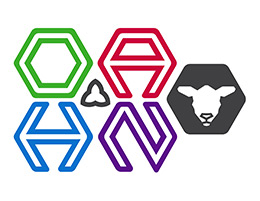Ontario Animal Health Network (OAHN)
Small Ruminant Expert Network
Quarterly Report
Highly Pathogenic Avian Influenza in U.S. livestock
A highly pathogenic strain of influenza A(H5N1) has been circulating in wild birds, poultry, and other mammals in the U.S. and Canada since 2022 and late 2021, respectively. Spillover events of HPAI H5N1 into U.S. livestock were first reported in March 2024 with the situation continuing to evolve. To date, there have been no detections of HPAI H5N1 in Canadian livestock. HPAI is a federally reportable disease to the CFIA in any species and is a zoonotic pathogen.
March 20, 2024: The first U.S. detection of HPAI H5N1 in domestic livestock was a goat kid in Minnesota.
- Unusual deaths of newly kidded goats were reported on a property where a backyard poultry flock was depopulated due to HPAI. The goats and poultry had access to the same space, including a shared water source; goats at the farm began to kid only days after the poultry were depopulated.
- Ten goat kids died, ranging from 5 to 9 days old. They displayed no clinical signs at birth and developed neurological signs including incoordination, inability to stand, difficulty nursing, seizures, blindness, etc. consistent with signs reported in some other HPAI-affected mammals. Other factors likely played a role in the illness, as HPAI was identified in only half of the kids tested.
- Brain and tissue samples from five goat kids tested positive for H5N1. Genomic sequencing showed that the HPAI in samples from the kids and poultry from the farm were highly related.
March 25, 2024: U.S. animal and public health officials report that H5N1 was detected in milk from ill dairy cattle from herds in Texas and Kansas.
- Wild migratory birds are believed to be the initial source of infection, with epidemiologic investigations at the federal and state (Michigan) level indicating risk factors for transmission between agricultural premises (dairy AND poultry) include movement of animals, shared workers, equipment, and vehicles between premises, highlighting the importance of biosecurity to prevent disease spread.
- Since the initial detection, >150 U.S. dairy premises have confirmed infection across 13 U.S. states. Updated livestock case information from the USDA can be found HERE.
May 28, 2024: USDA confirmed the detection of HPAI H5N1 in alpacas (the first in this species) from a premises where HPAI-affected poultry were depopulated in May 2024.
- The adult alpacas exhibited depression, weakness, and mild respiratory signs, including nasal discharge. The alpacas also experienced abortions/stillbirths. H5N1 was detected in the following sample types: nasal swabs and milk from adult females, and brain tissue from an aborted alpaca fetus.
- The HPAI confirmation was not unexpected due to the previous HPAI detection on the premises, the high amount of virus in the environment, and co-mingling of multiple livestock species on-farm.
What to do if you observe livestock with clinical signs consistent with Influenza A (H5N1):
- Producers should report clinical signs or suspected illness to their veterinarian immediately
- Veterinarians should contact their local CFIA animal health office if there is a high degree of suspicion
What to do if you find sick or dead birds or other wildlife on your property:
- Report these findings to the Canadian Wildlife Health Cooperative(CWHC) who may arrange for submission of wildlife for testing
Resources:
Updates from the Canadian Food Inspection Agency (CFIA): Information for producers and veterinarians on the latest Canadian information and guidance, including a description of clinical signs in affected cattle.
Updates from the U.S. Department of Agriculture – Animal and Plant Health Inspection Service: Updated case numbers of HPAI in U.S. livestock, biosecurity guidance, and milk safety documents.
Animal Health Laboratory Q1 2024 Case Data Summary
Prepared by Dr. Amanda Mansz, AHL Pathologist
Below: Q1 2024 small ruminant case submission totals (left) and case trends (right).
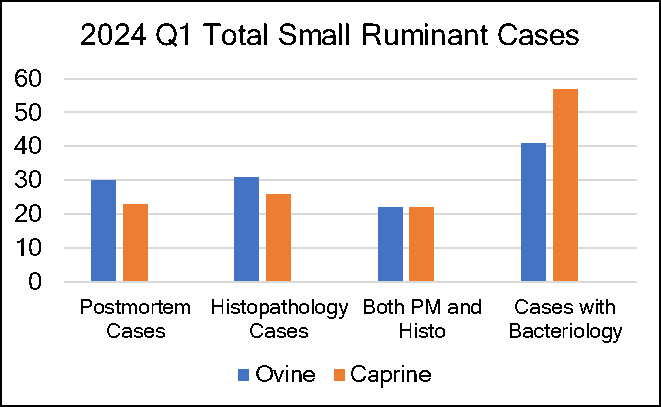
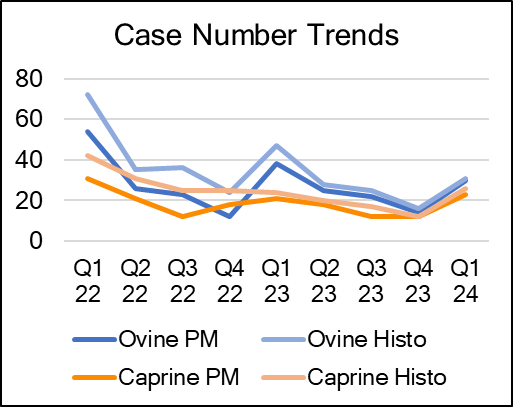
- 30 ovine postmortem cases were submitted to the AHL and OVC-PBI during 2024 Q1. 31 histopathology cases from both laboratory and on-farm postmortems/biopsy were also examined by pathologists, the majority of which were abortion workups (22 cases). 22 cases had both postmortem and histology performed (73% of total postmortems submitted).
- 23 caprine postmortem cases were submitted during 2024 Q1. 26 histopathology cases from both laboratory and on-farm postmortems/biopsy were also examined by pathologists, the majority of which were abortion or pneumonia workups (9 cases each). 22 cases had both postmortem and histology performed (96 % of total postmortems submitted).
Below: Abortion case findings for ovine (left) and caprine (right) workups.
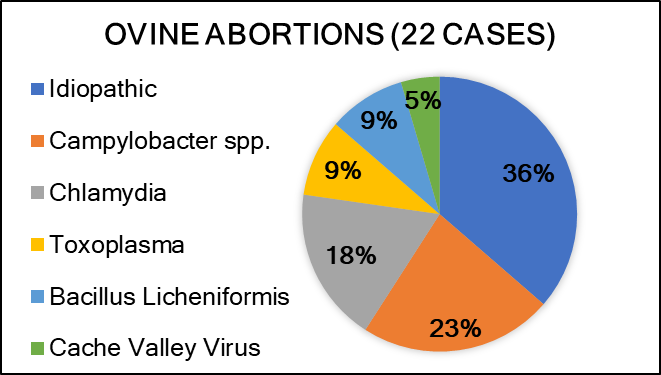
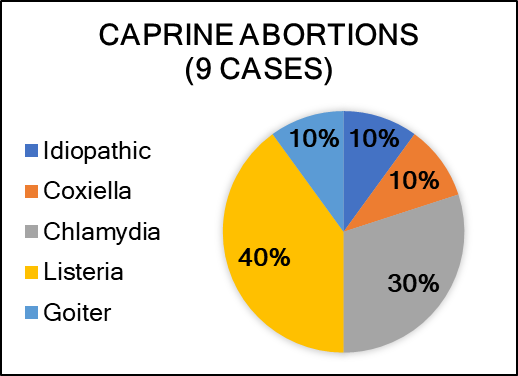
- The total number of ovine (22) and caprine (9) abortion cases submitted in Q1 was similar to Q1 in 2022 and 2023
- Ovine comments: Campylobacter abortions (5) were much higher than the previous 2 years (total of 5 diagnosed in past 8 quarters – 4 Campylobacter fetus, 1 Campylobacter jejuni). 6/8 (75%) of idiopathic abortion cases did not receive a full work up (histopathology, bacterial culture and PCR tests for Chlamydia, Coxiella and Toxoplasma) and/or had no histo lesions to suggest infectious cause (suspected noninfectious causes).
- Caprine comments: Listeria (4 cases) was diagnosed much more than the past 2 years (previously none since the 2 cases in Q1 2022), Chlamydia and Coxiella diagnoses were similar to previous quarters. The single idiopathic abortion had mild microscopic inflammatory lesions with no agents determined.
Click here for an AHL newsletter article on Ruminant Listeriosis highlighting characteristics of the organism, clinical pictures and diagnosis
Below: Respiratory case findings for ovine (left) and caprine (right) workups.
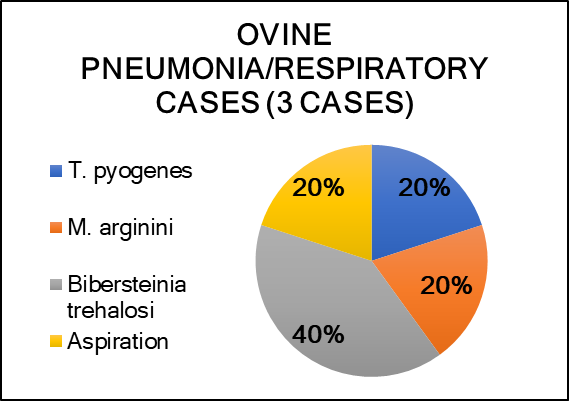
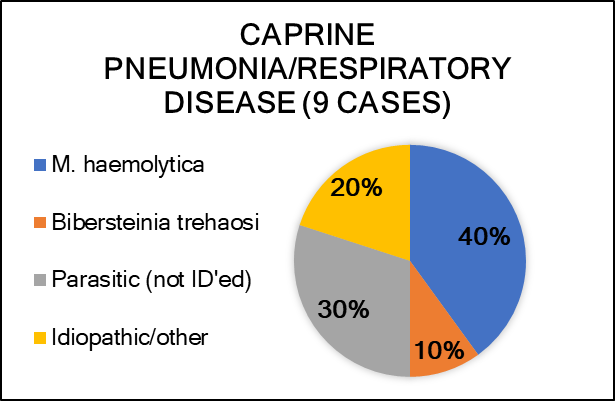
Ovine comments: Case numbers are on trend with previous quarters (few). Mycoplasma ovipneumoniae was not diagnosed but there was one case of M. arginini diagnosed in a 4 yo (adults more commonly affected). No cases of Maedi-Visna Virus (MVV) or Nasal adenocarcinoma were diagnosed by pathologists.
Caprine comments: Cases of M. haemolytica were increased (75%) from previous year (only two were typed and both were type II). Idiopathic included 1 case Thymic lymphoma, 1 case suspected Caprine arthritis encephalitis (CAE) or Mycoplasma (not tested). No cases of CAE were diagnosed by pathologists.
Interesting case highlight: Systemic vasculitis and lower urinary tract obstruction in a lamb caused by ovine herpesvirus-2
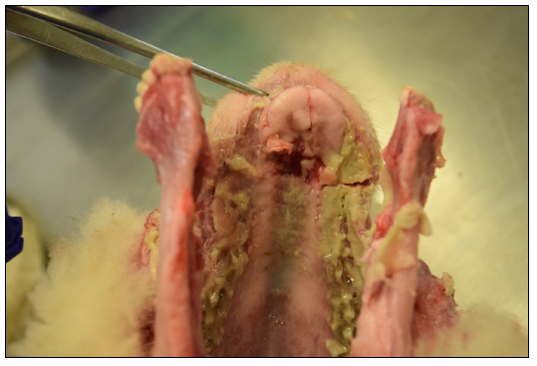 SIGNALMENT: 8-week-old Dorset ram lamb with six-day history of stranguria and dribbling urine.
SIGNALMENT: 8-week-old Dorset ram lamb with six-day history of stranguria and dribbling urine.
CLINICAL EXAM: Obstruction in the vermiform appendage, fibrin cast in prepuce, difficulty breathing and thick plaques of white exudate on the roof of the mouth.
DIAGNOSIS: Histopathologic lymphocytic and neutrophilic vasculitis in various tissues, including oral and esophageal mucosa, penis, prepuce, and heart. PCR testing of the oral and esophageal mucosa was positive for OvHV-2 with cycle thresholds of 22.88 and 25.01, respectively.
Click here for the full AHL newsletter article!
Animal Health Laboratory Q1 2024 Case Data Summary Continued
| Sheep | Goats | |
| CNS | Cases were down 30% from last Q – only 2 CNS cases were diagnosed, both attributed to Listeria monocytogenes. | Cases were up 50% from last quarter (4 total). 1 case with brain lesions was attributed to enterotoxemia (FSE) which is uncommon in goats. 1 idiopathic case showed vacuolation/necrosis in hind brain – Scrapie negative, suspect parasite migration. The remaining two cases were diagnosed as listeria and polioencephalomalacia. |
| Maedi-Visna Virus/ Caprine arthritis encephalitis (CAE) | Maedi-Visna: The number of serologic tests performed decreased to 31 cases (564 individual serum samples); from 44 cases (1191 samples) the previous quarter. The positive case rate (≥1 positive samples per case submission) was 22% which is on trend with the previous quarters. | CAE: The numbers of serologic tests performed for CAE virus slightly increased from previous quarters with a case number of 57 (1313 serum samples) whereas the previous quarter was 40 cases (787 samples). There were 14 positive cases (39 samples) which is on trend with previous quarters. No cases were diagnosed by pathologists. |
| Johne’s Disease | Submissions continued at the same relatively low rate. Only 2 cases (4 samples) were submitted for ELISA and 2 cases (4 samples) for PCR. With 2 cases identified by PCR. | Submissions continued at the same rate as previous quarters. A total of 49 cases (213 samples) were tested (32(172) ELISAs and 17(41) PCRs). 5 cases (6 samples) were positive by ELISA and 5(5) positive by PCR. An additional one case was diagnosed by a pathologist. |
| Copper Toxicity | No cases. | No cases |
| Scrapie | There were 2 cases (2 samples) submitted for testing; NO positive cases. | There were 0 cases submitted for testing. |
| GI Parasitology | Decreased this quarter by about 40% (6 cases). As usual, the most frequently identified parasites were coccidia and Strongyloides. There was only 1 case each of GINs, Trichuris, and Cryptosporidia. NO cases of haemonchus were diagnosed by pathologists. | Submissions for examination were on par with previous quarters (16 cases (20 samples)). The most frequently identified parasites by flock were coccidia (8 cases), GINs (3), Trichuris (4), and Cryptosporidia (3). There was a single case of cestode/Moniezia and one of Strongyloides. No case of haemonchosis were diagnosed by pathologists. |
| Clostridium perferingens | Isolation was similar to previous quarters; 7 cases isolated C. perfringens and 5 were genotyped. Only 1 was typed as C. perfringens type D causing enterotoxemia (1 type A, 3 type A with Beta-2 toxin). One case of Enterotoxemia was diagnosed based on pathology alone. | Isolation was similar to previous quarters. 9 cases isolated clostridium perfringens and 4 were genotyped. Two were typed as type D causing enterotoxemia (1 type A, 1 type A with Beta-2 toxin). No cases of Enterotoxemia were diagnosed based on pathology alone. |
| Salmonella | 9 cases of bacterial culture received Salmonella enrichment but there was only 1 Salmonella isolation, typed as SIIIb:61:k:1,5,7 which was a case of neonatal enteritis (infection in utero vs. from environment were possibilities). | 8 cases of bacterial culture received Salmonella enrichment, and none were positive for Salmonella isolation. |
| Enteritis | Cases (including pathogens like ETEC, EPEC, Rotavirus, other bacteria, rumenitis, bloat and idiopathic – excluding parasites, Johne’s, C. perf, Salmonella) were very few as usual. Only one enteritis case was diagnosed and was attributed to ruminal bloat. | Cases (including pathogens like ETEC, EPEC, Rotavirus, other bacteria, rumenitis, bloat and idiopathic – excluding parasites, Johne’s, C. perf, Salmonella) were very few as usual. Only one case was diagnosed in this section and was positive for PCR detection of Rotavirus. |
Provincial Abattoir Slaughter & Condemnation
Prepared by Dr. Hannah Golightly, OMAFA
Below: Provincial slaughter (left) and condemnation (right) data for goat, sheep and lamb, January 2023 to May 2024.
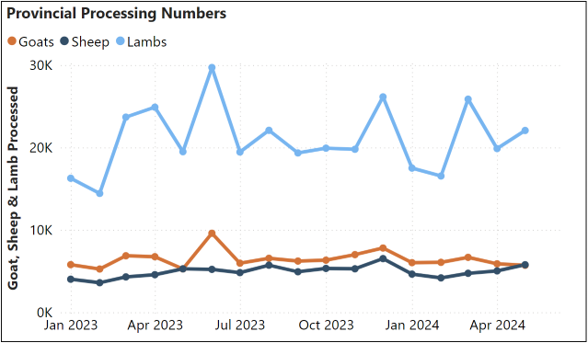
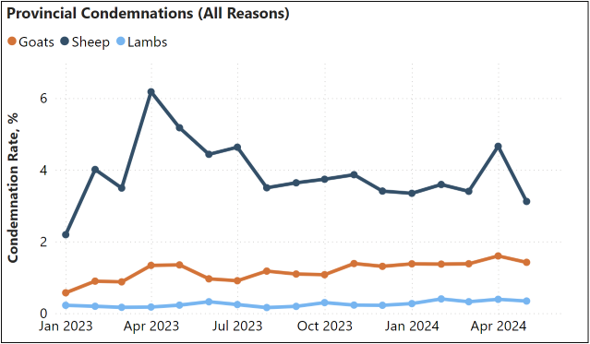
Below: Condemnation reasons for sheep, goat and lamb slaughtered at provincial abattoirs, January to May 2024.
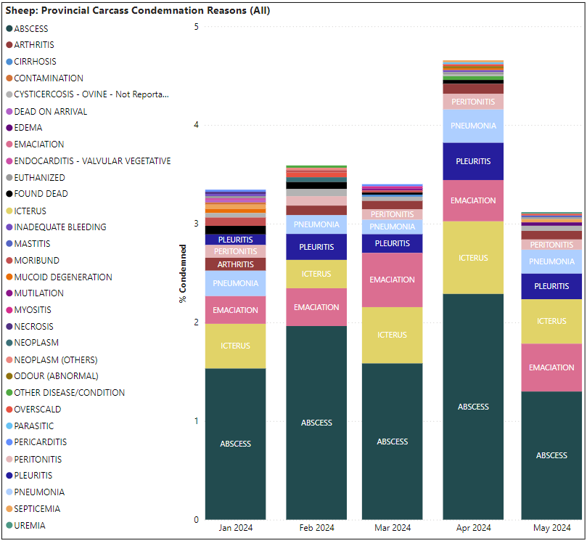
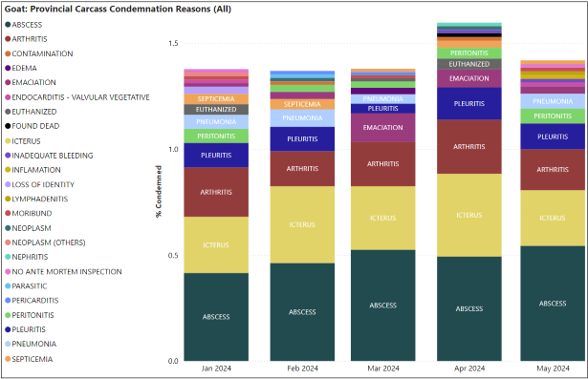
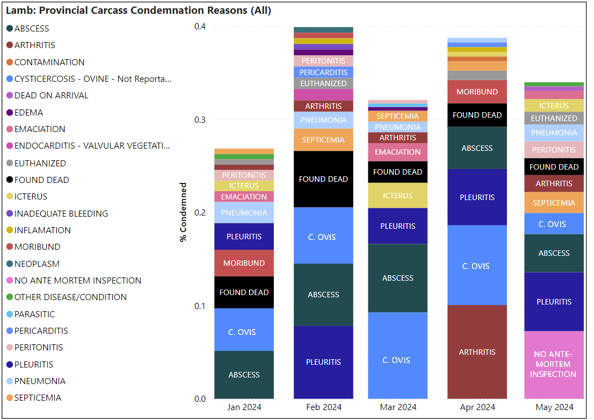
Comments:
Top 3 condemnation reasons for sheep (abscess, icterus, emaciation) and goats (abscess, icterus, arthritis) remain consistent over 2024 to date.
Top condemnation reasons for lambs appears more variable with condemnations due to evidence of C. ovis infection being prominent throughout 2024 so far.
Canada’s Code of Practice for the Care and Handling of Sheep to be updated – provide your input by July 25th
The Canadian Sheep Federation (CSF) has initiated an update to the Code of Practice for the Care and Handling of Sheep. The update will be guided by NFACC’s Code development process. The Code development process includes a survey, launched at the outset of each Code, to capture top-of-mind welfare concerns from any and all stakeholders. The input received will help the Code Development Committee understand the kinds of issues people wish to see considered in the update.
Everyone is invited to participate; the survey for this Code will be open until July 25, 2024, and is available at https://www.nfacc.ca/codes-of-practice/sheep.
Small Ruminant Research Highlights
- Cache a Killer: Cache Valley virus seropositivity and associated farm management risk factors in sheep in Ontario, Canada – PMC (nih.gov)
- A Scoping Review on the Epidemiology of Orthobunyaviruses in Canada, in the Context of Human, Wildlife, and Domestic Animal Host Species – PubMed (nih.gov)
- A Scoping Review on the Epidemiology of Orthobunyaviruses of Canadian Public and Animal Health Relevance in the Context of Vector Species – PubMed (nih.gov)
- A randomized control trial investigating the effectiveness of a commercial pneumonia vaccine (part I): Pre-weaned lambs – ScienceDirect
- A randomized control trial investigating the effectiveness of a commercial pneumonia vaccine (Part II): Weaned lambs – ScienceDirect
CgFARAD Seminar on Prudent Drug Use
Aug 7, 2024, 1-4:30pm ET on Zoom, free for participants
Including “What we know about anti-inflammatories in small ruminants” – Dr. Emily Reppert, Kansas State University – see the full agenda here (includes the meeting link)
Reminder: Find more small ruminant resources on the OAHN Small Ruminant Network Page
